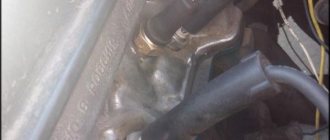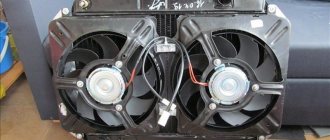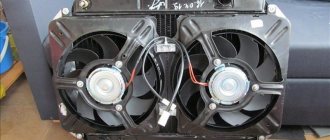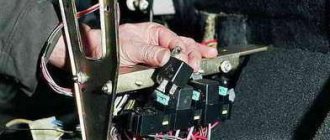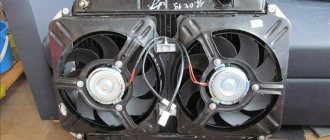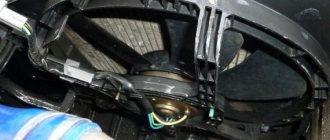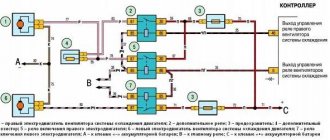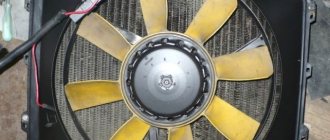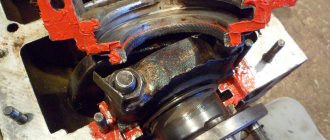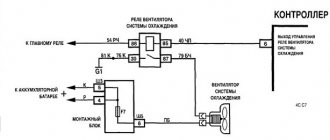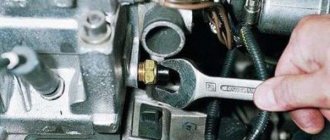Sometimes car owners are faced with a situation when the cooling system fan turns on and starts working when the engine is cold. Although, under normal operating conditions of this element, it must be activated only when the temperature of the internal combustion engine reaches certain values.
There are many reasons why this situation occurs on modern cars. Some of them can lead to serious negative consequences if measures are not taken in time to eliminate the causes and provoking factors.
To understand the situation, you need to find out the reasons for turning on the fan, understand its operation and find the best methods to solve the problem.
Diagnostics
Before trying to determine why cooling system fans may turn on when the engine is cold in cars, it is recommended that you understand the operation of this unit.
The fan is turned on due to the operation of a special sensor, which activates the rotation of the blades. This controller is located at the bottom of the cooling radiator.
There are some modern cars where the engine control unit is responsible for starting, although this is rather a rarity and the exception and the rule.
When the cooling liquid (coolant) reaches the required temperature, which is usually in the range of 100-105 degrees Celsius, the sensor closes the electrical circuit, and this allows the fan to turn on. It starts blowing on the radiator. This achieves a better cooling effect, since the air and liquid systems are combined.
At the same time, there are situations when the engine is still absolutely cold, it does not require any additional cooling, but the fan still turns on. This is not a normal condition. It is necessary to look for the reason for this behavior of the cooling system and eliminate any malfunctions that have arisen.
If you continue to ignore the constantly running fan, the initially simple discomfort will give way to more serious problems. But here it is important to note that the constant operation of the blades is not as dangerous as a complete failure of the device. Although this fact is absolutely not a reason to do nothing.
It all starts with diagnosis. The simplest and most convenient in this regard are injection engines. To detect a malfunction, it is enough to conduct computer diagnostics. This is done both in a car service center and in the garage with your own hands.
Connecting to an electronic control unit makes it possible to obtain error codes that are not difficult to decipher and understand the true reasons for this behavior of the cooling system fan.
There are situations when the ECU detects a malfunction in the cooling system and causes the fan to spin constantly, even when the engine is cold. This is a kind of protective function aimed at preventing possible overheating of the internal combustion engine. Therefore, when errors are detected and after troubleshooting, a reset is required. To erase errors, you should look at the owner's manual for your car. On some cars, it is enough to remove the terminal from the battery, and the errors will be erased. On other cars, errors are erased using connected diagnostic equipment.
If the option of computer diagnostics does not suit you or it cannot be used for one reason or another, you will have to use the method of elimination to check all potential sources of trouble.
Lack of fluid in the unit
The sensor partially fails with the smallest amount of liquid. Even in the presence of antifreeze, the sensor immediately warms up. This process can disrupt the entire function of the system and cause many problems. Such a malfunction is characterized by a banal oversight.
With careful monitoring, you can get rid of serious problems and breakdowns. To do this, you need to check the amount of liquid. Since during evaporation there is no liquid in the radiator
If there is a small amount of liquid, the temperature reaches the unit temperature. For example, if you start the engine, it will not be completely heated, but the fan will immediately cool down. This process occurs due to the fact that the liquid heats up very quickly in the unit. Problems can be resolved in the simplest way. By adding a little antifreeze, you can avoid air locks in the system.
Common faults
Since the fan is spinning, it needs to be forced to stop and turn on only when there is a real need for it.
There are several main reasons why cooling system fans may turn on when the engine is cold. This is related to:
- switch on sensor;
- coolant;
- mass;
- thermostat;
- temperature sensor;
- contacts;
- air conditioning.
Each of the points may be the reason why the fan turns on and starts rotating when the engine is cold.
Power sensor
One of the most common reasons why a fan runs on a cold engine is a short circuit in the controller, that is, the sensor.
Quite often it happens that the fan starts when the ignition is turned on. If this occurs at the same time, the contacts on the controller have probably shorted. As a result, the airflow works constantly.
CJIeM 15 Sep 2014
Thanks everyone for the advice.
Guys, I removed the chip from the temperature sensor (the one in the radiator). When I take it off, the fan goes silent. I connected the chip to the sensor and it turns again.
Sergey RV Yes, I didn’t go very deep into the description, and the fact that some models have two modes (speeds) of fan operation. TS immediately wrote that he removed the ring from the sensor and the fan turned off. This means that the little one is no longer in the sensor circuit.
What does this mean? Need to change the sensor?
How to make a replacement
If you are convinced that the cause of the malfunction lies in the fan motor, then the easiest way to carry out repairs is to completely replace the device. In this case, there is no point in spending money on a new casing. It will be cheaper to just buy a new electric motor.
Necessary tool
No special tool is needed. The work is carried out simply using 8 and 10 socket wrenches and a Phillips screwdriver.
Step-by-step algorithm of work
You can replace the cooling fan motor without removing the radiator.
- Disconnect the connector and device wiring harness from the casing.
- Unscrew the mounting bolts using a 10mm wrench.
- Unscrew the lower fastening nut.
- Using a 10 mm socket wrench, unscrew the mounting nut from the radiator.
- Using a size 8 socket wrench, unscrew the two pressure plate nuts.
- Remove the plate.
- Remove the electric fan along with the casing.
- Let's start dismantling the electric motor. Using a 10 mm wrench, unscrew the three mounting nuts and remove the engine along with the blades.
- Using a screwdriver, pry up the lock washer.
- And take it off.
- Remove the impeller.
- Put the impeller on the new motor. Make sure that the shaft pin fits into the impeller groove.
- Reassemble in reverse order.
Engine exhaust
Cooling fans, of course, play an extremely important role in maintaining the operating temperature of the power unit in all modes of its operation.
However, modern cars also use a crankcase exhaust valve, which allows for additional cooling of the engine and prevents the formation of soot on the engine walls. The task of the crankcase exhaust valve is to open at strictly necessary moments and release oil, fuel and water vapors that accumulate in the engine into the manifold.
Such electronics function as follows. A sensor is installed in the engine crankcase, which analyzes the current gas pressure in the system and constantly transmits information to the ECU. The latter, in turn, checks the information provided by the sensor and releases gases if their pressure reaches a certain value. Thus, additional cooling of the engine occurs and prevents it from clogging.
ECU
If the diagnosis of all other elements did not help, then the cause of the breakdown is a malfunction of the electronic control unit. But this doesn't happen often. It is not always possible to determine this malfunction on your own. Therefore, if an independent check does not give positive results, you should contact a car service center.
If the ECU fails, it is flashed to remove all existing errors or the unit is replaced. These procedures should be performed by an auto electrician. It is not advisable to do such work without experience. This device is not cheap, but, fortunately, it is replaced quite rarely. There are also several other very rare reasons why the cooling fan may not turn off. Unlike the malfunctions described above, they can usually only be identified and eliminated at a service station.
Tuning VAZ → XX rises after Carlson's work
I found an explanation of this problem on the Internet, but I still don’t understand where these wires need to be cut off and which ones, because... The article doesn’t say this, maybe someone has encountered this and can suggest something.
——————————VAZ-2115 with ECU VS-5.1 (V5V13L05). Complaint about a jump in idle speed when the engine is fully warmed up. The defect was reproduced by me in a workshop. The following happens: while the warm-up is in progress and there has not been a single turn on of the fan, the throttle valve position (THR) obediently stands at zero and returns to zero after repeated throttle changes of varying depths. After turning the fan on, the throttle is still at zero, but after turning the fan OFF it jumps by 1 or 2 percent. With a steady unit in the throttle, the return after throttling sets the THR to 2% or 3% with the idle raised to 2400 rpm. Nothing helps other than turning off the engine and starting it again. As soon as the fan turns on and off for the first time, the speed jump will repeat. One more detail - if the fan turns on when the idle is stuck (2% - 3% in the throttle), then the THR drops to 0% and the idle drops to normal. As soon as the fan turns off, the idle rises to the previous 1200-2400 rpm and the throttle is again 2-3 percent open. Of course, the throttle in all these observations is physically completely closed. The PDZ sensor was changed by the client and by me, I also changed the ECU - it’s not their fault. It was also noticed that when the fan is turned on, the temperature readings in the MT jump up by several degrees. Suspicions of a poor sensor mass are confirmed by measuring the mass of the TPS relative to the mass of the engine. When the fan is not running, the potential difference is zero, but turning on the fan results in an excess of the TPS mass by 0.08 volts according to the digital voltmeter. I removed, scraped, and tightened the brown masses of the ECU on the block, compressed all the branching masses in the interior bundle - no effect. I would be surprised if it did - all the connections that I cleaned and crimped were in perfect condition. I connect the TPS ground and the engine ground with an additional wire - there is no effect. Desperate to achieve equality of the masses COMING FROM THE SAME POINT (cylinder block), I cut off the mass of the fan from the mass of the ECU (yes, the mass is supplied to the fan from the crimping of large brown wires in the ECU bundle) and put it directly on the body - victory! All the glitches with a jump in THR and speed are gone, and the temperature readings also stopped jumping when the fan is turned on. I wonder what idiot thought of designing the wiring in such a way, where the mass of the power consumer (fan) is physically combined with the mass of the electronics, where the count is in hundredths of a volt! (https://www.autodevice.ru/praktica4.htm) collapse thread
what do not you understand ? I think everything is clearly and clearly described. There are masses. on 5.1-61 they are two brown wires that hang on the cylinder head studs on the side where the thermostat is.
I won’t go into the assignments, but in general terms, one wire supplies ground to the sensors, one goes to the brains. This is what the article says about this.
In short, read it several times and you will understand everything yourself. + find the mass diagram.
Personally, I advise you to check whether these brown wires are on different bolts or on one. must be on different ones. clean them again.
materials on the topic https://chiptuner.ru/content/ground/https://chiptuner.ru/content/ground2/https://chiptuner.ru/content/pub_05/
The diagrams are here somewhere. search and you will find https://chiptuner.ru/content/docs/ collapse thread
Dmitry https://atomic-dm.ru Thank you Kudryavtsev, with your explanation it became more clear!
Dmitrius “Bad” boy ツ Kozhemyakin if I put the mass of the fan on the body, the fan will always rotate, even when the car is turned off. After all, plus it goes from the battery to collapse the branch
Source
Main types of radiator cooling fans
Today there are only two types of fans:
- Mechanical;
- electronic.
Mechanical (works when the crankshaft rotates). To maintain the integrity of the device and blades at high speeds, the fan impeller is connected to the pulley via a hydromechanical drive.
When the crankshaft rotation speed increases, the clutch performs light braking to prevent damage to the device. Although earlier the first models of vases did not have such a device.
Electronic. With the development of technology, electronic drives began to be in demand. It consists of two main components - a control system and an electric motor. The use of electronics made it possible to ensure uniform cooling of the power unit and eliminate the risk of damage to the fan.
